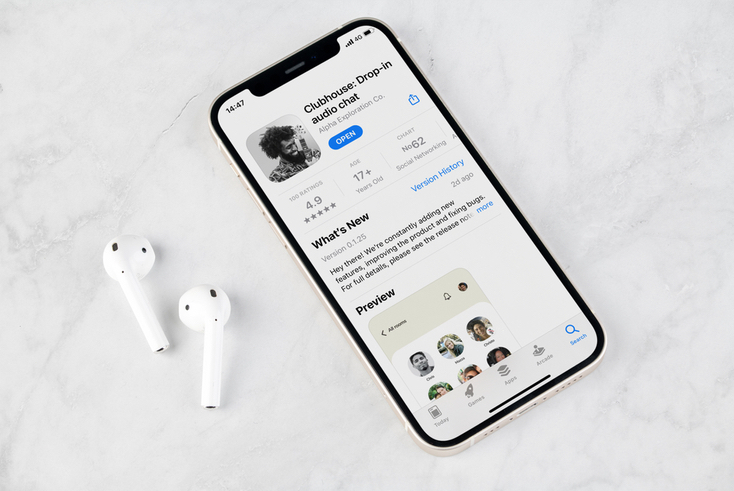Join the club

Mary Keane-Dawson, group CEO of influencer agency TAKUMI, explains why there is such a buzz around one of the newest social media platforms and the potential opportunities for brands to get involved
The rise of Clubhouse has been astronomical. From humble beginnings, the audio-only social platform launched at the start of the pandemic in March 2020 with just 1,500 users at a reported $100 million valuation. Just less than a year on, Clubhouse has surpassed eight million downloads globally and was recently valued at $1bn.
Most notably, within the space of just over two weeks – from February 1 to 16 2021 – downloads of Clubhouse more than doubled from 3.5 million to 8.1 million, showing the platform’s steep growth trajectory.
But what is it and why is there such a buzz? And, more importantly for brands, how can they make the most of it?
What is Clubhouse and why is it valuable to brands?
Amid the sustained rise in popularity of podcasts – accelerated by social restrictions – Clubhouse emerged as a challenger audio-only social media platform with a difference.
Firstly, Clubhouse is operating on an exclusive invite-only model while in its current beta stage of development. Once users have gained access, they can navigate or organise chatrooms to listen into or contribute to conversations across a range of themes and formats. Examples include blind dates, commenting on live events, and discussions with celebrities and business leaders such as Kanye West and Elon Musk.
At a time when many of us have ‘completed’ Netflix and are sick of Zoom calls, audio-only content and informal conversation can be a powerful medium. Particularly when you have a highly engaged audience which has actively sought your content and is giving your message sustained attention.
What are the opportunities for brands and how can they capitalise?
Current engagement figures on Clubhouse don’t quite stack up compared with other more established social media platforms, due to its relatively smaller number of users. However, that doesn’t mean there aren’t opportunities for brands on Clubhouse now, and certainly these will increase in the future as its popularity continues to grow and the app’s marketing capabilities develop.
[advert position=”left”]
Brands can use Clubhouse as an effective tool to facilitate consumer engagement. For example, hosting branded events or organising talk shows with expert commentators and celebrity endorsers.
Alternatively, brands could also sponsor events that align with their brand personality. For example, Headspace could sponsor a meditation room or Nike could sponsor interviews with professional athletes.
Depending on how brands choose to use the platform, it can support a range of marketing objectives from raising brand awareness to generating sales.
But whatever it is, brands must adapt their content output on Clubhouse to be impactful and engaging without the aid of visuals, and above all to deliver value to their audience.
Influencer marketing opportunities
Influencers have shown they’ve been able to successfully adapt and transition to new channels following the emergence of TikTok. Their success has seen many more brands considering multi-channel approaches.
For example, Haagen-Dazs approached TAKUMI for support on its ‘Secret Sofa’ campaign incorporating Instagram and TikTok, and we also helped Wickes launch the UK’s first home improvement industry campaign on TikTok.
Transitioning from YouTube or Instagram to TikTok is one thing, but Clubhouse represents a very different type of social media format for influencers to turn their hand to. In a live format there is more risk, but also potentially huge rewards, with an opportunity to directly communicate with fans.
It is these large gatherings of highly engaged followers where brands can benefit most from influencer marketing. For example, they can establish a partnership with an influencer to host a weekly conversation where they can incorporate brand messaging or promote products.
This can be powerful if the content remains authentic and is useful to the audience too. Simply using Clubhouse as a platform to sell goods is not going to deliver value for either audience, influencer or brand.
The future of Clubhouse
Clubhouse recently raised significant investment and will surely develop its services and marketing capabilities while its user base continues to grow.
Already the money is being used to fund a ‘Creator Grant Program’, due to launch within months. The program will help to support Clubhouse creators, suggesting its focus is on high quality content as its primary method for attracting more users and high-profile creators. And this also surely suggests there will be an important place for influencers on the platform in the future.
But Clubhouse still has some way to go to truly disrupt an already crowded market. It will need to carve itself a niche, particularly as Twitter has launched its own audio-only format called Spaces.
And it will also need to learn from the successes and failures of other platforms. Could Clubhouse replicate Twitch’s subscription model or elements of Instagram Live’s interactivity, for example?
The future will provide the answers, but the present day shows Clubhouse already has plenty of promise.




